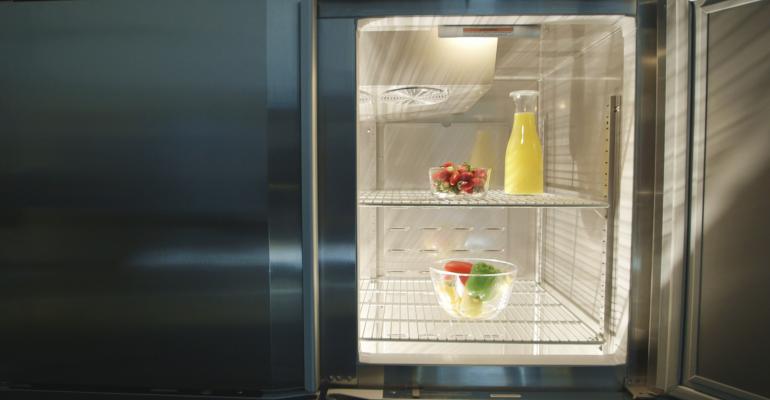Sponsored by Hoshizaki
Kitchens are cramped, hot places in which to work, and performing optimally under such conditions is equally challenging both for chefs and the equipment operating within the space.
Upright refrigerators might have it the worst of all. Positioned beside ovens and flaming ranges that push room temps above 100 F, they are expected to keep food cold and safe for customer consumption — even with hurried cooks opening and closing their doors dozens of times per hour. Keeping temperatures low under such conditions creates stress on refrigerator compressors, blowers, door gaskets and every surface inside and out. Such machines must be built to endure ongoing wear and tear year after year.
Toughness and chilling capacity are just the basic requirements, says Jake Kimmel, product manager, refrigeration at Hoshizaki America, in Peachtree City, Ga. They must be designed to possess as small a footprint as possible, and airflow must be constant throughout the cabinet to ensure temperatures are equal throughout the enclosure. These qualities and many more, he says, have been designed into the company’s newest Steelheart upright reach-in line of refrigerators.
All functions improved
“We looked at every component of a refrigerator and asked how we could improve it,” Kimmel says. “From the smallest function to the largest, we found ways to make it even better.”
Kimmel says Steelheart’s ability to cool efficiently begins with the use of R290, a hydrocarbon, environmentally friendly refrigerant recognized as a safe alternative to R134a and R404 refrigerants. He says R290 also yields better energy efficiency from the compressor.
Perhaps surprisingly, Steelheart's new smaller exterior footprint results in larger storage capacity within the unit. By relocating the evaporator from inside the food storage compartment to the top of the unit, the Steelheart consumes less lateral space than some of its Hoshizaki siblings. The narrower profile provides more room for other equipment, as well as improved air circulation all around it.
“Users get increased food storage space without sacrificing kitchen floor space,” Kimmel says. Additionally, the top of the unit can now serve as a shelf to hold lightweight items needed on the line. “Things such as cups or napkins can be stored on top of the units, which wasn’t previously possible since the top wasn’t covered. It’s another way to maximize space in the kitchen.”
A cold, cold breeze
Temperature unevenness in upright refrigerators is a multifaceted problem. At its simplest, the problem occurs when a unit is overloaded with product. At its most troublesome, the unit’s ductwork doesn’t distribute chilled air evenly or efficiently.
According to Kimmel, the Steelheart moves cold air through a system of ducts and louvers positioned throughout the cabinet. Circulating air from top to bottom and at each individual shelf, the food within is surrounded by the cold air, which ensures uniform temperatures. To deal with warm product overload, the unit’s unique Thermostatic Expansion Valve (TXV) boosts refrigerant flow for rapid recovery when needed.
“Scalloped louvers on our ducted airflow system ensures air movement occurs even when the cabinet is packed with food,” Kimmel says. “It’s a much better design than a through-hole that can easily be blocked from distributing air.”
Condensation problems? No sweat!
No matter whether you’re cooking in a dessert, kitchens are humid environments because of the cooking process. When heat forces moisture bound within food outside it, the moisture becomes airborne.
For refrigerators, which must dry air in order to cool it, humidity is a potential enemy because moisture-laden air is more difficult to cool than dry air. Also, when humid air cools, moisture that condenses out of it must be collected and drained safely and/or evaporated back into the air.
“Evaporating the condensate is the best way to manage it so it doesn’t become a problem in the form of puddles or drips on the floor,” Kimmel says.
The Steelheart solution, he says, is an evaporator system mounted atop the refrigerator that “contains a reservoir with hot gas lines to evaporate condensate. It also has a large condenser fan that creates airflow near the reservoir that increases evaporation.”
A heart of steel
As the Steelheart name implies, the entire upright refrigerator is made of durable, corrosion-resistant stainless steel. The hard, sleek metal is designed to take the punishment of hurried kitchen staffs, food spills, countless cleanings and scrubbings over many years of use. Units with insulated plastic or lighter metals simply don’t compare, Kimmel says.
“Why would you want anything less than the best for your food storage?” he says.



